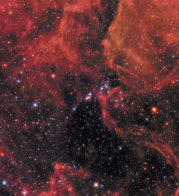
Since their discovery 67 years ago, neutrinos from a range of sources – solar, atmospheric, reactor, geological, accelerator and astrophysical – have provided ever more powerful probes of nature. Although neutrinos are also produced abundantly in colliders, until now no neutrinos produced in such a way had been detected, their presence inferred instead via missing energy and momentum.
A new LHC experiment called FASER, which entered operations at the start of Run 3 last year, has changed this picture with the first observation of collider neutrinos. Announcing the result on 19 March at the Rencontres de Moriond, and in a paper submitted to Physical Review Letters on 24 March, the FASER collaboration reconstructed 153 candidate muon neutrino and antineutrino interactions in its spectrometer with a significance of 16 standard deviations above the background-only hypothesis. Being consistent with the characteristics expected from neutrino interactions in terms of secondary-particle production and spatial distribution, the results imply the observation of both neutrinos and antineutrinos with an incident neutrino energy significantly above 200 GeV. In addition, an ongoing analysis of data from an emulsion/tungsten subdetector called FASERν revealed a first electron–neutrino interaction candidate (see image).
“FASER has directly observed the interactions of neutrinos produced at a collider for the first time,” explains co-spokesperson Jamie Boyd of CERN. “This result shows the detector worked perfectly in 2022 and opens the door for many important future studies with high-energy neutrinos at the LHC.”
The extreme luminosity of proton–proton collisions at the LHC produces a large neutrino flux in the forward direction, with energies leading to cross-sections high enough for neutrinos to be detected using a compact apparatus. FASER is one of two new forward experiments situated at either side of LHC Point 1 to detect neutrinos produced in proton–proton collisions in ATLAS. The other, SND@LHC, also reported its first results at Moriond. The team found eight muon–neutrino candidate events against an expected background of 0.2, with an evaluation of systematic uncertainties ongoing.
Covering energies between a few hundred GeV and several TeV, FASER and SND@LHC narrow the gap between fixed-target and astrophysical neutrinos. One of the unexplored physics topics to which they will contribute is the study of high-energy neutrinos from astrophysical sources. Since the production mechanism and energy of neutrinos at the LHC is similar to that of very-high-energy neutrinos from cosmic-ray collisions with the atmosphere, FASER and SND@LHC can be used to precisely estimate this background. Another application is to measure and compare the production rate of all three types of neutrinos, providing an important test of the Standard Model.
Beyond neutrinos, the two experiments open new searches for feebly interacting particles and other new physics. In a separate analysis, FASER presented first results from a search for dark photons decaying to an electron-positron pair. No events were seen in an almost background-free analysis, yielding new constraints on dark photons with couplings of 10–5 to 10–4 and masses of between 10 and 100 MeV, in a region of parameter space motivated by dark matter.
Further reading
FASER Collab. 2023 arXiv:2303.14185.
FASER Collab. 2023 CERN-FASER-CONF-2023-001.





